
Meet Miz Jane
FAA Administrator Makes Third Trip To OSH
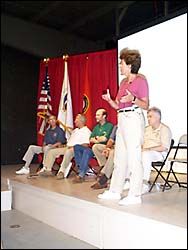 FAA Administrator Jane Garvey continues to impress aviation people with herwillingness to both listen to and answer the hard questions, something some ofher predecessors are not remembered for doing well. Sunday at EAA AirVentureOshkosh, she spent an hour in a give-and-take session that touched on everythingfrom the mandatory retirement age for airline pilots to unqualified airplanemechanics. Garvey was joined onstage at the "Meet the Boss"session by several top-level FAA types, including Steve Brown, with FAA airtraffic services; Tom McSweeney, associate administrator for certification andregulation; and Monte Belger, assistant administrator. By and large, though, herassociate and assistant administrators sat quietly and Garvey answered thequestions.
FAA Administrator Jane Garvey continues to impress aviation people with herwillingness to both listen to and answer the hard questions, something some ofher predecessors are not remembered for doing well. Sunday at EAA AirVentureOshkosh, she spent an hour in a give-and-take session that touched on everythingfrom the mandatory retirement age for airline pilots to unqualified airplanemechanics. Garvey was joined onstage at the "Meet the Boss"session by several top-level FAA types, including Steve Brown, with FAA airtraffic services; Tom McSweeney, associate administrator for certification andregulation; and Monte Belger, assistant administrator. By and large, though, herassociate and assistant administrators sat quietly and Garvey answered thequestions.
In contrast, Garvey’s boss, Transportation Secretary Rodney Slater, had quitea bit to say. Slater, a first-time OSH visitor, was given the blue-ribbon tourof the show grounds by EAA President Tom Poberezny, and seemed impressed withwhat he had seen. "The thing that excites me most is all the children atthe event," he told the crowd gathered to hear Garvey. "The EAA’sYoung Eagles program is a wonderful step to the future." After finishinghis prepared statement, Slater moved aside to let his FAA Administrator get downto the serious business of aviation’s challenges.
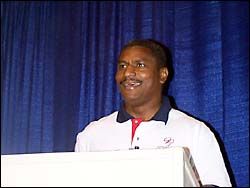 Before taking questions, Garvey talked a little about issues she and theagency are dealing with now, including the push to streamline airman medicalcertificates. She expects that change to come in October. "Streamline"is an important word in Garvey’s vocabulary. It is one of her goals, as iskeeping the lines of communication open. Garvey is often visibly annoyed whenpilots at public forums tell her they have not been able to get any responsefrom whichever FAA department they have been trying to contact. More than onceSunday, in fact, she directed assistants to meet with questioners right afterthe Meet the Boss session.
Before taking questions, Garvey talked a little about issues she and theagency are dealing with now, including the push to streamline airman medicalcertificates. She expects that change to come in October. "Streamline"is an important word in Garvey’s vocabulary. It is one of her goals, as iskeeping the lines of communication open. Garvey is often visibly annoyed whenpilots at public forums tell her they have not been able to get any responsefrom whichever FAA department they have been trying to contact. More than onceSunday, in fact, she directed assistants to meet with questioners right afterthe Meet the Boss session.
No Bill Bainbridge/Bob Hoover lightning-rod issue has jelled the aviationworld this summer, so the questions at Sunday’s session ran the gamut. As theydo every year, several people stood up and asked about the airline pilot age 60rule, which the FAA is showing no sign of changing. One pilot unrolled a longwhite banner listing the countries that allow pilots to fly to age 65 andlonger. Garvey was unswayed, telling the questioners she has seen no evidence toconvince her the rule should be changed.
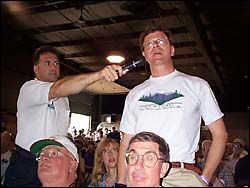 Jerry Hooker, of Hooker Harnesses, told of problems getting product fieldapprovals; and George Braley, of General Aviation Modifications Inc., spoke up on the challenge of toofew project engineers being available at project certification offices. Garveytalked about the ongoing battle of the budget and the need for continued toughdecisions about what can be paid for with the agency’s limited funds. On theissue of field approvals, Garvey said she would like to see as many fieldapprovals as possible while "maintaining consistency."
Jerry Hooker, of Hooker Harnesses, told of problems getting product fieldapprovals; and George Braley, of General Aviation Modifications Inc., spoke up on the challenge of toofew project engineers being available at project certification offices. Garveytalked about the ongoing battle of the budget and the need for continued toughdecisions about what can be paid for with the agency’s limited funds. On theissue of field approvals, Garvey said she would like to see as many fieldapprovals as possible while "maintaining consistency."
Garvey was also forced to defend the new ATC readback requirements, which shesays aren’t new at all, but simply "clarifications" to the existingrules. "We felt there was some confusion," she said, "and weneeded to clarify what is the responsibility of pilots and controllers."Garvey said that pilot input on such issues is crucial, and that the agencyprobably should have done a better job of talking this particular issue throughbefore implementing it.
Garvey told the crowd several times that public sessions like Meet the Bossare valuable in that they allow her to hear about what’s going on. With everypassing session, more people seem to believe her.
AVweb Goes One On One
After the Meet the Boss session, AVweb sat down with Garvey to talk a bitmore about the FAA and general aviation. Garvey praised the General AviationCoalition that meets four times a year and focuses the agency on GA-specificissues, but stressed the value of picking up the phone before making changesthat will affect the industry. "Pick up the phone and call a couple offolks, and say, hey, what’s your take on this? I tell you, Monte [Belger,assistant administrator] and I both do that. I want to be clear, this doesn’tmean we’ll always be in agreement [with GA groups]. We are willing to makechanges when we need to, but there are certain times that in our role asregulator we’ll make decisions some won’t agree with."
Belger asked AVweb and the rest of the aviation media to encourage pilots andmanufacturers to raise issues and ask questions. "I think it’s easier ifissues are raised sooner rather than later, before people at the lower levels[of the FAA] get entrenched." How does that desire for input correspondwith rulings made with seemingly no give-and-take from pilots and airplaneowners, such as the recent turbocharged twin Cessna proposed AD? The AD was discussed with the FAA twoyears ago, disappeared, then reappeared, going in just one week from Notice ofProposed Rulemaking (NPRM) to final rulemaking. Without admitting outright theAD was a foul-up, Garvey and Belger said they and other high-ranking FAAofficials need to make certain their expectations are made clear to lower-levelstaff. Getting those crystal-clear expectations to 47,000 FAA employees willprove no easy task.
May The Force Be With You
Jim Franklin Goes Jet Age
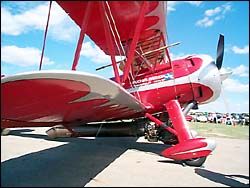 Visitors to EAA AirVenture get to see a lot of unusual things every year, butthis year, they’re hearing something odd, too — the distinctive sound of a jetengine coming from a 1940 Waco. Airshow pilot Jimmy Franklin freely admits thefreakiness of his contraption, but is mighty pleased with its performance. Hestarted his airshow career in the Waco with a 220-hp engine, moved to a 330 hp,450 hp, then to a 600 hp, which turned out to be too much for his airframe tohandle. The need for power and speed remained. The answer was to return to the450-hp Pratt & Whitney on the nose, and mount a GE CJ610-6 jet engine, theequivalent of the military J-85, on the underside of the old Waco’s fuselage.
Visitors to EAA AirVenture get to see a lot of unusual things every year, butthis year, they’re hearing something odd, too — the distinctive sound of a jetengine coming from a 1940 Waco. Airshow pilot Jimmy Franklin freely admits thefreakiness of his contraption, but is mighty pleased with its performance. Hestarted his airshow career in the Waco with a 220-hp engine, moved to a 330 hp,450 hp, then to a 600 hp, which turned out to be too much for his airframe tohandle. The need for power and speed remained. The answer was to return to the450-hp Pratt & Whitney on the nose, and mount a GE CJ610-6 jet engine, theequivalent of the military J-85, on the underside of the old Waco’s fuselage.
The sound of the jet wasn’t something Franklin put much thought into, but ithas been a happy by-product. "Sound effects are 50 percent of theshow," he told AVweb. The Waco now roars past the crowd with power enoughto climb at more than 10,000 feet per minute. The thought of hanging raw thruston the front of the Waco occurred to Franklin back in 1978, but it took teamingup with Les Shockley, of Shockwave Jet Trucks, to make it happen. "I askedLes how it would work and he said, ‘Jimmy, you take care of flying the thing,and I’ll take care of making it work.’ It’s a very exciting airplane tofly."
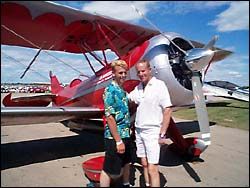 The Waco was beefed up structurally when Franklin put the 600-hp engine onit, so it handles the extra speed with nary a complaint. EAA AirVenture is justthe sixth airshow Franklin has flown with the jet addition, so he’s keeping hisroutine a little more tame than he might like. "I have an idea foradditional maneuvers. I’ve tested some other gyroscopic maneuvers and aninverted flat spin." Franklin plans to work those maneuvers into hisroutine next season. Right now, though, the impact of the plane is doing a lotof his work for him. "People are just shaking their head and laughing. Youhear this old round engine and then all of a sudden, you hear this jet go by. Itjust leaves them with their mouths hanging open."
The Waco was beefed up structurally when Franklin put the 600-hp engine onit, so it handles the extra speed with nary a complaint. EAA AirVenture is justthe sixth airshow Franklin has flown with the jet addition, so he’s keeping hisroutine a little more tame than he might like. "I have an idea foradditional maneuvers. I’ve tested some other gyroscopic maneuvers and aninverted flat spin." Franklin plans to work those maneuvers into hisroutine next season. Right now, though, the impact of the plane is doing a lotof his work for him. "People are just shaking their head and laughing. Youhear this old round engine and then all of a sudden, you hear this jet go by. Itjust leaves them with their mouths hanging open."
Diamond Aircraft, Utah Valley State College Announce Partnership
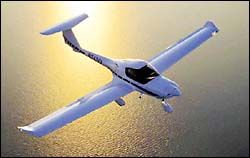 Utah Valley State College will purchase 15 Katana DA20-C1 TeledyneContinental-powered aircraft, the first three of which will be delivered here atAirVenture ’99. "The DA20-C1 was selected by UVSC to replace our fleet ofsix Katana A1’s, which we have operated for the last five years," said RonSmart, dean of UVSC’s aviation program. The college, based in Provo, had fourstudents in 1991 and has grown to 600 this year. Smart also said that UVSC is looking forward to the addition of the DA40four-place version of the Katana just as soon as it becomes available. "Ourassociation with Diamond will be a major part of our future growth," hesaid.
Utah Valley State College will purchase 15 Katana DA20-C1 TeledyneContinental-powered aircraft, the first three of which will be delivered here atAirVenture ’99. "The DA20-C1 was selected by UVSC to replace our fleet ofsix Katana A1’s, which we have operated for the last five years," said RonSmart, dean of UVSC’s aviation program. The college, based in Provo, had fourstudents in 1991 and has grown to 600 this year. Smart also said that UVSC is looking forward to the addition of the DA40four-place version of the Katana just as soon as it becomes available. "Ourassociation with Diamond will be a major part of our future growth," hesaid.
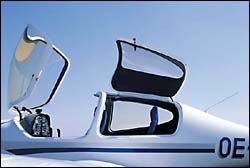 Peter Chambers, the new owner of Diamond Aircraft, added that Diamond willdonate a Katana Vision One FTD simulator training device to the college and alsomake an Xtreme motorglider available for student use. In support of the launchof UVSC’s new Global Aviation Degree Program, Chambers said he intends to make asignificant gift to the college, which will be announced soon. "If you areserious about helping aviation grow, you must be innovative, take bold actionand make commitments," Chambers said.
Peter Chambers, the new owner of Diamond Aircraft, added that Diamond willdonate a Katana Vision One FTD simulator training device to the college and alsomake an Xtreme motorglider available for student use. In support of the launchof UVSC’s new Global Aviation Degree Program, Chambers said he intends to make asignificant gift to the college, which will be announced soon. "If you areserious about helping aviation grow, you must be innovative, take bold actionand make commitments," Chambers said.
Diamond Aircraft, based in London, Ontario, is the world’s leadingmanufacturer of type-certified composite general aviation aircraft, with morethan 1,500 Katanas delivered worldwide.
NASA Predicts High Times For GA
In The Near Future AGATE Efforts Bearing Fruit…
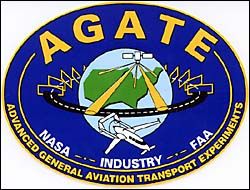 If we can believe NASA’s forecast, the future of GA is so bright, we gottawear shades. NASA briefed AirVenture ’99 attendees on the latest developments inthe Advanced General Aviation Transport Experiments (AGATE) program, initiatedin 1994 to revitalize the stagnant GA industry. Thegovernment-industry-university consortium is using advanced technology toaddress GA deficiencies in safety, affordability and ease-of-use. According toNASA, the prototype Williams FJX-2 low-cost turbofan and TCM diesel enginesdeveloped under AGATE are now being run on test stands and should be flying intest aircraft next year at this time. Advanced avionics providing datalink,real-time graphical weather in the cockpit are almost ready to go, and work onsynthetic vision systems is moving from simulation to flight testing. Finally,the FAA and the Cargo Airline Association conducted successful in-flight testsearlier this summer of the NASA-backed ADS-B cockpit traffic informationdisplay.
If we can believe NASA’s forecast, the future of GA is so bright, we gottawear shades. NASA briefed AirVenture ’99 attendees on the latest developments inthe Advanced General Aviation Transport Experiments (AGATE) program, initiatedin 1994 to revitalize the stagnant GA industry. Thegovernment-industry-university consortium is using advanced technology toaddress GA deficiencies in safety, affordability and ease-of-use. According toNASA, the prototype Williams FJX-2 low-cost turbofan and TCM diesel enginesdeveloped under AGATE are now being run on test stands and should be flying intest aircraft next year at this time. Advanced avionics providing datalink,real-time graphical weather in the cockpit are almost ready to go, and work onsynthetic vision systems is moving from simulation to flight testing. Finally,the FAA and the Cargo Airline Association conducted successful in-flight testsearlier this summer of the NASA-backed ADS-B cockpit traffic informationdisplay.
… As Seeds Planted For Small Aircraft Transportation System …
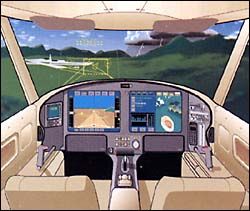 After providing the status report on the AGATE effort, NASA unveiled plansfor the Small Aircraft Transportation System (SATS) program at a forum titled"Life After Airliners." AGATE Program Manager Dr. Bruce Holmes, fromNASA Langley Research Center in Virginia, said the primary goal of SATS is toprovide instrument approach capabilities to every public-use runway in theUnited States by integrating advanced SATNAV capabilities with new cockpitavionics developed under AGATE. Holmes coined the word "hublock" todescribe the future commercial carrier situation as major airports will beunable to meet the large increases in passenger traffic. Since building majornew airports is prohibitively expensive, the only real answer is to increase thecapabilities of the thousands of existing small airports in the country. Holmesshowed the forum crowd a futuristic video of how pilots would benefit from SATSin the next century. Reminiscent of those old black-and-white "this is yourfuture" films, the video depicted pilots flying light jets effortlesslybetween small public airports in any type of weather. Crucial to theimplementation of SATS, according to Holmes, is strong support from stategovernments who could benefit from the economic boom all-weather airports couldprovide to small rural communities overlooked by the major carriers.
After providing the status report on the AGATE effort, NASA unveiled plansfor the Small Aircraft Transportation System (SATS) program at a forum titled"Life After Airliners." AGATE Program Manager Dr. Bruce Holmes, fromNASA Langley Research Center in Virginia, said the primary goal of SATS is toprovide instrument approach capabilities to every public-use runway in theUnited States by integrating advanced SATNAV capabilities with new cockpitavionics developed under AGATE. Holmes coined the word "hublock" todescribe the future commercial carrier situation as major airports will beunable to meet the large increases in passenger traffic. Since building majornew airports is prohibitively expensive, the only real answer is to increase thecapabilities of the thousands of existing small airports in the country. Holmesshowed the forum crowd a futuristic video of how pilots would benefit from SATSin the next century. Reminiscent of those old black-and-white "this is yourfuture" films, the video depicted pilots flying light jets effortlesslybetween small public airports in any type of weather. Crucial to theimplementation of SATS, according to Holmes, is strong support from stategovernments who could benefit from the economic boom all-weather airports couldprovide to small rural communities overlooked by the major carriers.
…But Burt’s Not Buying It
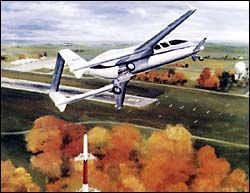 Sharing the stage with Holmes at the Sunday forum was futurist, GAevangelist, and Scaled Composites President Burt Rutan, who disagreed with muchof what Holmes presented. Lobbing good-natured jabs at Holmes, Rutan declaredthat his biggest problem with NASA’s version of the GA future is that it is tooconservative — the federal agency needs to be much more creative. If Rutan hadhis way, government would let private enterprise and the competitive market setthe standard for future aviation transportation systems. Rutan brought a roar ofapproval from the forum crowd by stating that the solution to GA problems willbe solved "not by regulation, but by technology." Citing the recentcrash involving John F. Kennedy Jr., Rutan said the technology is availabletoday, at low cost, to provide an intuitive, continuous virtual horizon to theaverage pilot no matter what the weather conditions.
Sharing the stage with Holmes at the Sunday forum was futurist, GAevangelist, and Scaled Composites President Burt Rutan, who disagreed with muchof what Holmes presented. Lobbing good-natured jabs at Holmes, Rutan declaredthat his biggest problem with NASA’s version of the GA future is that it is tooconservative — the federal agency needs to be much more creative. If Rutan hadhis way, government would let private enterprise and the competitive market setthe standard for future aviation transportation systems. Rutan brought a roar ofapproval from the forum crowd by stating that the solution to GA problems willbe solved "not by regulation, but by technology." Citing the recentcrash involving John F. Kennedy Jr., Rutan said the technology is availabletoday, at low cost, to provide an intuitive, continuous virtual horizon to theaverage pilot no matter what the weather conditions.
Rutan also doesn’t envision SATS as the light aircraft transportation systemof the next century. Instead, Rutan floated the intriguing idea that towns andcities could be equipped with very short "aircraft capture facilities"for catapulting and recovering light aircraft, similar to systems used on anaircraft carrier. Such a system would allow many more "landing" areas,take up less room than conventional airports, and be integrated within cities toeliminate the need for a car when arriving at a destination. Rutan finished hissermon to the AirVenture faithful by declaring that he would continue to beproactive in fighting to make the best technology available to GA pilots withless government interference. He encouraged the attending pilots to demand thesame from their elected officials.
Seaplane Base Cool Respite From Hot Convention Grounds
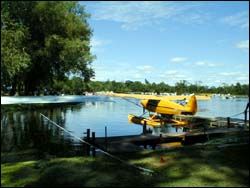 Looking to takea break from the hectic pace of the main convention site, AVweb visitedthe AirVenture ’99 seaplane base on Lake Winnebago to check out the floatplanesand amphibs that flew to Oshkosh. Arriving at the base several miles southeastof Wittman Field, visitors are treated to a view of floatplanes gently rockingat their moorings in a tranquil cove, surrounded by huge shade trees. SeaplaneBase Management Chairman Mark Wrasse told AVweb that more than 100seaplanes were registered at the base during AirVenture ’99. The cove is onprivate land co-owned by John and Susie Vette, and Gary and Burleigh Blust. Thefamilies generously donate the cove for use during the annual convention — theother 51 weeks it is not used as a public seaplane base.
Looking to takea break from the hectic pace of the main convention site, AVweb visitedthe AirVenture ’99 seaplane base on Lake Winnebago to check out the floatplanesand amphibs that flew to Oshkosh. Arriving at the base several miles southeastof Wittman Field, visitors are treated to a view of floatplanes gently rockingat their moorings in a tranquil cove, surrounded by huge shade trees. SeaplaneBase Management Chairman Mark Wrasse told AVweb that more than 100seaplanes were registered at the base during AirVenture ’99. The cove is onprivate land co-owned by John and Susie Vette, and Gary and Burleigh Blust. Thefamilies generously donate the cove for use during the annual convention — theother 51 weeks it is not used as a public seaplane base.
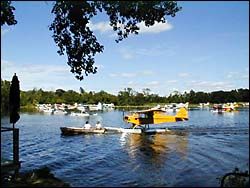 The majority ofplanes at the base were certified types like Cubs, 180s, and Maules. Butscattered among the factory birds were experimentals such as the GlaStar, Rans,and Kitfox on floats. Wrasse said they are seeing an increasing number ofexperimentals every year at the base, as more homebuilders discover the fun offlying off water. Wrasse mentioned that last Friday he observed a higher numberof visitors than normal riding the shuttle buses from Wittman Field to the base,but not all of them came to gawk at seaplanes. Seems many of them brought theirbathing suits to beat the record heat with a dip in the cool waters of LakeWinnebago.
The majority ofplanes at the base were certified types like Cubs, 180s, and Maules. Butscattered among the factory birds were experimentals such as the GlaStar, Rans,and Kitfox on floats. Wrasse said they are seeing an increasing number ofexperimentals every year at the base, as more homebuilders discover the fun offlying off water. Wrasse mentioned that last Friday he observed a higher numberof visitors than normal riding the shuttle buses from Wittman Field to the base,but not all of them came to gawk at seaplanes. Seems many of them brought theirbathing suits to beat the record heat with a dip in the cool waters of LakeWinnebago.
Briefs…
AVweb‘s Howard Fried Visits The FAA Pavilion
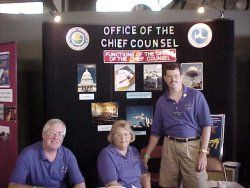 Those who know Howard and those who regularly read his AVweb column are going to findthis hard to believe, but (are you sitting down?) he actually had something goodto say today about the FAA. Everyone who has visitedEAA’s AirVenture is familiar with the huge auditorium in the FAA Pavilion whereforums are going on all the time and where the "Meet the Boss" programis held, but thatauditorium contains only a small part of the action at the FAA Pavilion. Beforeone enters the auditorium, he/she must walk through the building, past a largeroom full of booths, each of which is devoted to one or another of the manyfacets or divisions of the agency. Each booth is staffed by folks from aparticular division of the agency, who are there to help pilots understand thefunctions of their segment of the FAA’s vast bureaucracy.
Those who know Howard and those who regularly read his AVweb column are going to findthis hard to believe, but (are you sitting down?) he actually had something goodto say today about the FAA. Everyone who has visitedEAA’s AirVenture is familiar with the huge auditorium in the FAA Pavilion whereforums are going on all the time and where the "Meet the Boss" programis held, but thatauditorium contains only a small part of the action at the FAA Pavilion. Beforeone enters the auditorium, he/she must walk through the building, past a largeroom full of booths, each of which is devoted to one or another of the manyfacets or divisions of the agency. Each booth is staffed by folks from aparticular division of the agency, who are there to help pilots understand thefunctions of their segment of the FAA’s vast bureaucracy.
Although Howard wassurprised by the small amount of space devoted to ATC and to Flight Service, theother booths include divisions like Flight Standards Booths (it takes threebooths to cover them), followed by aeromedical, legal, and so on. One of themajor attractions is the Vertigon machine, which offers the opportunity toexperience spatial disorientation. The Vertigon can realistically simulatelosing control of an airplane in a turn in IMC by providing a graphicdemonstration of just how our senses can deceive us. The ride in the Vertigon isvoluntary, but it is something every pilot should experience. The machine is operated byexperienced safety program managers from FSDOs throughout the Great LakesRegion. Even though we (and especially Howard) all find a lot wrong with the FAA,the bottom line is that everyone who comes to EAA AirVenture should definitelyfind time to visit the FAA Pavilion and learn all about the agency that governseverything aeronautical in the U.S.
Aerobatic Awards Recognize Grassroots Pilots
The International Aerobatic Club has inaugurated a new program to reward thebest aerobatic pilots at the 180-hp level. The "Grassroots AchievementAward" medallion will go to the highest-scoring pilots at each of the IAC’s46 regional contests held each year. A new national trophy will be presented atthe IAC Aerobatic Championships, along with a $1,000 cash prize. "Nowowners of Cubs, Citabrias, Decathlons, Skybolts, Stardusters and similaraircraft will have an exciting achievement goal that will truly be within theirreach," said Doug McConnell, president of IAC. The program is supported byTextron Lycoming.
Power To The People
 REG Technologies, of British Columbia, was at AirVenture ’99 trying to drumup support for its revolutionary Rand Cam diesel rotary engine. REG, which hasbeen working on the design since 1987, said its number-crunching predicts it ispossible to build a 250-hp aircraft engine that weighs only 200 pounds andoffers dramatic reductions in noise, vibration, emissions and fuel consumption.The basic engine design is simple, using only two moving parts, and wouldcompletely eliminate the electrical ignition system. Rand Cam is seekingadditional funding in hope of having a fully functional Rand Cam engine atAirVenture next year, and a flying unit in 2001.
REG Technologies, of British Columbia, was at AirVenture ’99 trying to drumup support for its revolutionary Rand Cam diesel rotary engine. REG, which hasbeen working on the design since 1987, said its number-crunching predicts it ispossible to build a 250-hp aircraft engine that weighs only 200 pounds andoffers dramatic reductions in noise, vibration, emissions and fuel consumption.The basic engine design is simple, using only two moving parts, and wouldcompletely eliminate the electrical ignition system. Rand Cam is seekingadditional funding in hope of having a fully functional Rand Cam engine atAirVenture next year, and a flying unit in 2001.
World’s Oldest Homebuilder And Pilot
Captain Ralph Charles, 99, the world’s oldest homebuilder and currentlicensed pilot, entertained the AirVenture crowd in Tent 2 on Friday. CaptainCharles was trained by Bernard Whelan, who was trained by Orville Wright. He haslogged more than 6,000 hours since learning to fly in the Roaring ’20s. Hecelebrated his 99th birthday by holding a pipe organ concert and taking a BFR.


































